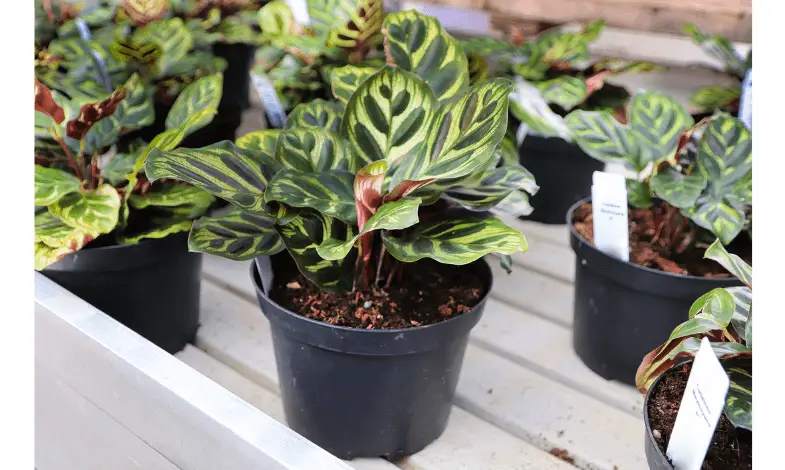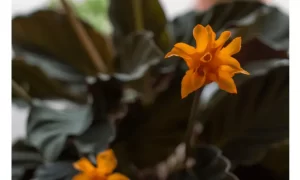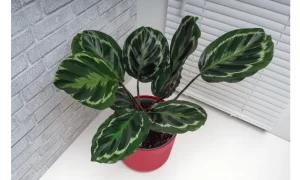5 Types Of Calathea (A to Z): If you are a greenery enthusiast, then the idea of intricate foliage should leave you breathless. It doesn’t take long for one to fall in love with such fine details and eye-catching attributes. Thus, it’s no surprise that a variety of Calathea is so popular amongst houseplant owners. And the amazing part is that you’ll be able to choose from many different types of Calathea.
Calathea appears in many shapes and forms, as mentioned earlier. All of them are unique and quite a treat to the eyes. It’s hard not to fall in love with their foliage. Calathea Roseopicta is one such Calathea that will get people’s attention with its strikingly bright foliage.
There are a plethora of glorious varieties of Calathea you can choose from. This is why I’ve put together a list of some of the most colorful and beautifully designed Calatheas. So, let’s have a look at some of the most wondrous varieties of this amazing houseplant.
Contents
The Many Different Varieties of Calathea
The many different varieties of houseplants are an important issue. Nevertheless, they all require somewhat the same care to grow into healthy and beautiful plants. And the same goes for the many different types of Calathea. It doesn’t matter which variety you’ll be choosing from. With the right love and care, your plants will experience problem-free growth.
To do so, you need to follow the general rules for taking care of houseplants. The soil that you’re growing the plant in must be rich in minerals and well-drained. The moisture must be kept in check at all times so that your plant can grow efficiently.
And let’s not cross out the need for a warm environment. Plants flourish in a well-kept environment with bright lights. It is better if you make it so that the light does not directly fall on the Calathea. It needs to be fed properly without being exposed to too much direct sunlight.
When you look at the different types of Calathea, you fall in awe of their exotic leaves and vibrant colors. It’s difficult to resist, for sure. That’s why many find it so difficult to stop collecting them in the first place. But believe me, when I say, it’s all worth it. Once you allow their exotic foliage to grace your humble abode, there’s no going back.
5 Types of Calathea
There are many different types of Calathea scattered around the globe. And each of them has unique characteristics of its own. Once you own one for yourself, you’ll know what I’m talking about. Below, I’ve listed a few different types of Calathea for you to witness.
-
Calathea Orbifolia
It’s not often that you come across a Calathea with metallic patterns. The Calathea Orbifolia sure takes the cake in making a pretty bold statement here. As mentioned earlier, Calathea will definitely grab your attention. And when it comes to this one, it’s a gem you don’t want to miss out on. Its vigorous foliage is enough to make it a keeper.
- Design and Pattern
Unlike many houseplants, the Calathea will give a more tropical feel to your house. It can grow into quite a sturdy plant, growing up to 2.5 feet in height and 12 inches wide.
The leaves are extremely beautiful, even if they have a leathery feel to them. It has silver stripes, which gives it a more exotic feel, and this is surely something to make its owner stay in awe.
- Temperature and Humidity
Now let’s look at how to give it the proper care that it deserves. I talked about how these Calatheas grow best when they are kept at a very warm temperature. The environment needs to be quite warm, fluctuating from 65 degrees Fahrenheit to 80 degrees Fahrenheit.
But you have to be on alert at all times. Heaven forbids, if the temperature drops below 60 degrees Fahrenheit, your Calathea will suffer severe damage, which will significantly stunt its growth. Your Calathea needs to thrive in the best environment. And you have to provide that at all costs. And when it comes to humidity, this isn’t something we can control. This is why you should expose your Calathea to a highly humid area on a regular basis.
- Soil and Fertilizer
Many make the mistake of growing their Calathea in soggy soil. This is not what we mean when we say to grow your Calathea in moist soil. Moist does not equal soggy. You need rich, moist soil that drains well. Otherwise, you’re not providing the correct atmosphere.
When it comes to fertilizers, I’d recommend once a month. This is crucial because almost all Calatheas are sensitive to sodium chloride. So once a month is more than enough. And your fertilizer shouldn’t be too strong. Make sure it is water-soluble; this will in addition lower its strength when being used. And don’t let it build up. Regular flushing of the soil is important to remove all the unnecessary build-up.
As we already talked about the temperatures, we should also dig into the things you shouldn’t provide for your Calathea. Cold locations. That is a primary concern as your Calathea needs to be kept far away from such an environment. It’s not that difficult to bring in artificial lights to help your plant grow.
The best part is that bright filtered lights are wonderful for such houseplants. They also result in the best growth and don’t hamper the color of the leaves. But this does not mean you can expose your Calathea to direct sunlight. That will just cause more harm than good as the bright light will burn the leaves to an extent.
So, it’s best to keep things at a moderate level. Always remember that if you end up exposing your Calathea to too little light or sunlight, you’ll just end up growing plants that will have a longer stem and few leaves at the top. And no one likes such leggy plants.
-
Calathea Warscewiczii
If you’re from Costa Rica, the chances are that you’ve come across Calathea at least once. The same goes for the people from Nicaragua. This Calathea is very tender and quite herbaceous. I would also say that it’s a fan favorite. Though looking at the name, I wouldn’t be surprised if most of us are unable to pronounce its name correctly.
Speaking of its interesting but quite difficult-to-pronounce name, it was named after the very famous and heroic polish botanist, Jozef Warszewicz.
Although it has a difficult name, it didn’t stop me from getting this Calathea for myself. And I would like to thank the fact that this Calathea also has another name. Calathea Jungle Velvet; now this is a lot easier to pronounce. And more delightful to the ears. I say this with due respect to Jozef and his last name of course.
- Design and Pattern
This Calathea has a very pointy and spear-like shape. Now the most interesting aspect of this plant is the leaves. It’s tremendously beautiful with its intricate design. The dark green leaves and lighter mellow ones intertwine and form a pattern that’s quite similar to that of a fishtail. If you look closely, you’ll also notice that underneath all that, there’s a hint of purple.
And that’s not all. If you’re familiar with the mimosa plant, you’ll know how it closes shut whenever touched. Now, this Calathea doesn’t need to be touched to operate that way. Because, in the evening, the leaves fold and close by themselves. It’s more similar to their family Prayer Plants.
Now when it comes to their growth, the foliage can be up to 12 inches in height. And the whole plant can grow up to 3 feet. It’s in winter when things get fascinating. You’ll see the Calathea growing tall spikes with white flowers dangling. These flowers can be seen for up to 3- or 4 weeks max. But this is strictly in winter or late spring.
- Temperature and Humidity
When it comes to taking care of such Calatheas, you need to follow the standard rules. They require the same not soggy but moist rich soil. And the temperature needs to be between 65 degrees Fahrenheit to 80 degrees Fahrenheit.
We previously discussed how it was difficult to find the right humidity. But you can raise the humidity by grouping your plants and using a humidifier. There are also humidity trays that you can purchase online which will get the job done and you won’t have to worry about whether your environment is humid enough.
Avoid cold locations at all costs. Bright indirect light is always preferred to direct sunlight. Direct sunlight will only burn the foliage and your leaves will just lose their precious color.
- Soil and Fertilizer
For fertilizers, monthly feeding is recommended. Salt burns will be detected if you overuse the fertilizers so limit their use. And the same goes for flushing them out to remove the unnecessary build-up. This is also why it’s recommended that you use a half-strength fertilizer so that you can wash away that more effectively.
-
Calathea Makoyana
Also known as the Peacock Plant, you’ll be flabbergasted by its remarkable colorful marks and its foliage which resembles an egg. When you look at their leaves, you’ll notice that the leaves are as thin as paper. This also means that they must be held and looked after with the utmost care.
- Design and Pattern
The undersides of the leaves, as usual, are purple and the whole leaf is a mixture of light and dark green markings. The Calathea can reach up to 12 inches in length when it comes to growth. And if you’re planning on getting this Calathea, I’d highly recommend that you prep the house beforehand. It might grow too tall, but it needs to be handled with care.
The stems of this Calathea are quite interesting. They are reddish-pink with leaves attached to them. The adult leaves are normally attached. But when the new leaves start forming, they appear rolled. This way, you can already see their purple undersides. Now when you put all of that together, it brings out a very colorful and not to mention, extraordinarily beautiful aura.
If you’re into flowers blooming, you might get a bit disappointed. You won’t see any blooming until spring. But even then, they are not of much significance and you’ll barely notice them. But that’s mostly the case for almost all Calathea houseplants.
- Temperature and Humidity
The right humidity and temperature are the same here as it was with all the other Calatheas. Just make sure that the soil is evenly moistened and that there is good drainage.
The humidity, as usual, needs to be high with temperatures ranging from 60 degrees Fahrenheit to 75 degrees Fahrenheit. And again, I repeat, no cold weather. You’ll just end up killing the poor thing.
- Soil and fertilizer
As all Calatheas are sensitive to salt, it’s no surprise that you have to tighten up the feeding schedule. Thus, you need to use Fertilizers only once a month and they must be water-soluble. And if you have to, make a schedule to regularly flush the soil. You don’t want any salt buildup to ruin your plant.
-
Calathea crocata
When it comes to Calathea Crocata, one can hardly take their eye off of this beautiful plant. It engrosses you with its Magnifique exterior with its divine and eye-catching flowers. The flowers are as bright as the eternal flame. This is nice considering that Eternal Flame is another name for this gorgeous Calathea.
Unfortunately, you won’t regularly find this Calathea online or in the marketplace. It may be quite popular with the masses but it has sustained a ton of damage over the years. Now you hardly see any of them in the wild.
If you’re a Brazilian, you might have come across some of them in your lifetime. But that’s only if you visit the jungle regularly. This Calathea is native to the jungles of Brazil but it’s a tragedy that the younger generation won’t get to see much of its presence due to the environmental damage.
- Design and Pattern
When you look closely, you’ll be astounded by the bright flowers of this Calathea. They come in shades of bright orange or yellow. The leaves are spear-shaped and you should remain wary of the spikes that the flowers dangle upon. When the flowers bloom, their bright colors usually last up to 2- or 3 months max. But it gets even better when those colors start to fade away.
The spear-shaped green foliage makes the Calathea even more attractive with its metallic look. And as they grow on an average of 1 to 2 feet in height, they’re the perfect pick for houseplants. That’s only if you can still find some in the market.
- Temperature and Humidity
The humidity and temperature best suited for this Calathea are pretty much the same as all the others. A warm and humid environment is ideal for its growth. And if you can tweak the temperature, just bring it between 65 degrees Fahrenheit to 80 Degrees Fahrenheit.
If you have several Calatheas at home, you can just keep them all in the same place as they require the same care and temperature. I’d recommend getting a humid tray or humidifier for the high humidity. And remember, bright indirect lights are best suited for the proper growth of your Calathea.
- Soil and Fertilizer
Water your Calathea regularly. But that doesn’t mean you can make the whole soil soggy with too much water. Just keep the soil moist and rich. When it comes to the sun, Calatheas all love a bit of sunlight. But direct heat from the sun is an absolute no-no. You don’t want to risk burning the foliage and ruining the entire plant.
So, keep it indoors with indirect light and provide half-strength fertilizers only once a month so as to not clog the soil with too much salt. And flush regularly to remove the build-up. Too much salt buildup will only stunt your plant’s growth.
-
Calathea Roseopicta
We’ve finally arrived at the last, but not the least, type of Calathea. The Calathea Roseopicta. The name itself is very intriguing. And one look at this Calathea, you’ll know what I’m talking about. But I won’t be biased but include all the information as to why it’s a favorite amongst the bunch.
If Roseopicta is too hard to remember, then you can call this beauty the Rose Painted Calathea. And the name certainly suits its glorious outlook. The leaves are beautifully structured with bright patterns, giving them a striking appearance.
- Design and Pattern
Similar to most Calathea, the undersides of the foliage are purple. The leaves are oval in shape and green on top. If you pay attention to the details, you’ll also notice that each of the leaves has its distinctive characteristics. The patterns are in such a way that the leaves look like outlines of even smaller leaves. More like leaves inside of leaves.
Unlike the others, the Calathea Roseopicta towers over 20 inches in height and width. You’ll also find them in various colors and intricate patterns.
- Temperature and Humidity
And when it comes to taking care of your Calathea, just pull out the usual guns as the process is the same as the others. Moist, rich soil that drains well. Temperature not be above 80 degrees Fahrenheit and try not to go below 65. A warm and humid climate is the go-to zone for your Calathea and you should refrain from exposing it to cold locations. No direct sunlight. Only bright indirect light for the best growth and robust colors.
- Soil and Fertilizer
Monthly fertilize with a not-so-heavy fertilizer and remove any salt residue whenever you see fit. And before you bring them home, get a humidifier or a humid tray first.
Read more about the Best Gardening Tools Set You Must Have
Conclusion: 5 Types of Calathea
Now that we’re at the end, I hope you now know that all types of Calatheas come in different shapes and sizes with beautiful patterns of their own. They require similar care and need to be handled diligently.
So, if you’re planning to get one, make sure you’ve done your research beforehand. And if you’ve already come this far at the end of the article, I’m sure you now know a thing or two. Thank you for giving this article a read. Hope you have an excellent day ahead!






